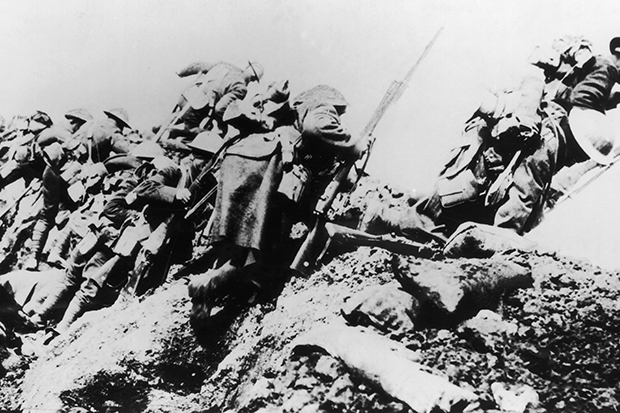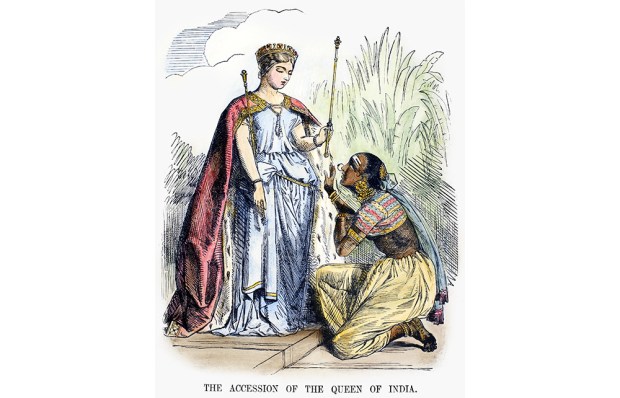Objectivity seems to be difficult for historians writing about Britain’s long and complicated relationship with India, and this makes the even-handedness David Gilmour achieves in books such as The Ruling Caste both unusual and welcome. In his enlightening and wonderfully detailed new portrait of The British in India, he states that he is ‘not seeking to make judgments or to contribute to any debate about the virtues and failings of imperialism’, although a brief Envoi supplies some ‘concluding reflections’ on what he acknowledges is a controversial subject. His is a social rather than a political history, focussing on what used to be known as Anglo-Indians not as mere representatives of colonialism but as ‘individuals trying to deal with the eternal problems of human behaviour and relationships’.
As Gilmour acknowledges, ‘India’s chief allure for Europeans of the 18th century was its wealth and the chance of getting their hands on some of it’. The usual way of doing this was as a servant of the East India Company (EIC). Equally ruthless trading and warfare characterised the early period of the British presence in India, and by the 1770s the EIC had its own large army, recruited from local people but commanded by British soldiers.
Originally formed to guard the Company’s properties and interests, it was subsequently used to expand its territories. As it conquered kingdoms, its merchants and accountants were increasingly obliged to combine ‘executive duties with private commerce’, and the Indian Civil Service was created to provide administrators. Gradually, alongside soldiers and Civilians (as members of the ICS were known), people began to come to India as engineers, foresters, planters, canal and railway builders, doctors and nurses, policemen, painters and missionaries, many of them leaving vivid accounts of their lives there.
Gilmour draws upon a wealth of both published material and unpublished official documents, letters, diaries and memoirs, and arranges his book thematically rather than chronologically, so that one gets a fascinating sense of how people from very different generations reacted to India. He begins by exploring people’s motivations for coming to the subcontinent, describes their working, domestic, amorous, social and sporting lives and their relationships with the Indians who vastly outnumbered them, and ends with their decision to ‘stay on’ or return to Britain, where it was often the case (as a character in a 1907 novel by A.E.W. Mason eloquently put it) ‘one misses more than one thought to miss, and doesn’t find half what one thought to find’.
Before the opening of the Suez Canal in 1869, even getting to India was a potentially hazardous undertaking, involving long sea voyages through sometimes treacherous seas and in frequently atrocious weather. Once there, the British had to adapt to the climate and customs of a country about which they often knew very little. The education provided for early Civilians at the IEC’s Haileybury College did more to foster an esprit de corps among its students than teach them much about the place and people they were to govern. Given how few British there actually were in India — even at the end of the 19th century, when the British Raj was at its zenith, they numbered a mere 155,000, ‘about a fifth of the size of the Glaswegian populace’ — a sense of group loyalty might well have seemed desirable.
That said, many of those who came to India in the 18th century took a genuine interest in the country’s culture, some of them adopting Indian clothes and habits and acquiring an Indian wife or ‘bibi’ (mistress). However, the arrival of the British memsahib and changing attitudes at home marked the end of this enlightened period, and all references to bibis in The East India Vade Mecum (1810) were expunged from the second edition (1825).
The EIC had refused to allow British missionaries in their territories on the pragmatic grounds that Indians were easier to govern and do business with if they were allowed ‘the undisturbed enjoyment of their respective opinions and usages’. Under pressure from the Evangelical movement, however, the British government made it a condition of renewing the Company’s charter in 1813 that missionaries should be granted access to the subcontinent. It is shocking to find William Wilberforce asserting that, after slavery, ‘the foulest blot on the moral character’ of Britain was that it allowed its Indian (by which he meant Hindu) subjects to remain ‘under the grossest, the darkest and most degrading system of idolatrous superstition that almost ever existed upon earth’; but this attitude was widespread among those who saw it as their religious duty to wean benighted ‘natives’ from their ‘disgusting and bestial rites’. Although the number of actual conversions to Christianity was laughably small, missionaries did much to alienate the indigenous population from its rulers and to foment grotesque notions of racial superiority that became a genuine blot on later British-Indian relations.
As well as helping provoke the catastrophic 1857 uprising, the activities of missionaries proved detrimental to more general military wellbeing. By exerting pressure to close down properly regulated cantonment brothels, Evangelicals did more to spread venereal disease than they did to spread the word of God. After the demise of the bibi, Civilians too had a pretty thin time of it sexually, particularly if they were posted to some isolated district. Most of them sought out a wife while on furlough back in Britain, but although communications between India and Britain had improved since they days when ‘a man writing to his fiancée from Calcutta at Christmas 1795 might not receive a loving reply before 1797’, geographical distance often still led to very protracted and fraught engagements.
Civilians were considered a good catch, one governor-general observing that while ‘a member of the Civil Service in England is a clerk, a member of the Civil Service in India may be a proconsul’. Women who sailed out to India in search of a husband were unkindly referred to as ‘the fishing fleet’, becoming ‘returned empties’ if they failed in their endeavours. It was in fact a huge commitment to leave behind one’s friends and family in order to find and live with a husband in a far-away country. Many wives were obliged to settle in remote districts where they may have enjoyed a retinue of servants but had no access to a local hospital, often having to travel hundreds of miles for their accouchements. The practice of sending children ‘home’ for their education proved particularly hard, some mothers being separated from their offspring for very long periods indeed. One couple left four children behind them in Scotland when they returned to India in 1839, including a baby whom they next saw when he was 11 years old. Returning to Britain to be with their children was, however, one way for unhappily married wives to effect a discreet separation.
During the Raj the British imported many of their home-grown prejudices and snobberies to the subcontinent, and Gilmour provides several instances of the ossification of a social life largely fenced off from the vast majority of the country’s population. Rules of precedence governed everything, including seating plans, with the result that people ended up being stuck next to the same person every time they attended a formal dinner. Actually getting as far as the table could involve meticulous social calibration: ‘one station-master’s wife felt she should go into dinner before another because her rival’s husband was “not on the main line”’. Going anywhere by rail had its own rules, and even the planter, who was generally looked down upon, was told to remember he was a sahib and must therefore ‘not lower his position by travelling in anything less than second class’, this ‘only permissible’ when his ‘financial position absolutely prohibits the luxury of first’.
Philistinism was endemic, with whist parties a more usual recreation than anything smacking of ‘intellectualism’. It was far more important for a sahib to be well dressed than well read, and Leonard Woolf was highly unusual in bringing 94 volumes of Voltaire with him to Ceylon. Gilmour suggests that the ritual of changing for dinner was not entirely absurd, even when dining alone in the jungle, given the climate and a day perhaps spent ‘inspecting the village drains or hacking one’s way through a forest’; but the number of different (and uncomfortable) outfits an official might require on a single day according to the different functions he was attending smacks of masochism.
A section on ‘Singularities’ describes some of those who did not conform to the social codes; and the sheer number and variety of witnesses that Gilmour provides throughout the book challenges the sweeping generalisations often made about the Raj. Covering almost every aspect of the British in India — from pets to pederasty, with a great deal in between — this is the best kind of history: meticulously researched, elegantly and entertainingly written, and as wide in its sympathies as it is long in its reach.
Got something to add? Join the discussion and comment below.
Get 10 issues for just $10
Subscribe to The Spectator Australia today for the next 10 magazine issues, plus full online access, for just $10.
You might disagree with half of it, but you’ll enjoy reading all of it. Try your first month for free, then just $2 a week for the remainder of your first year.














Comments
Don't miss out
Join the conversation with other Spectator Australia readers. Subscribe to leave a comment.
SUBSCRIBEAlready a subscriber? Log in